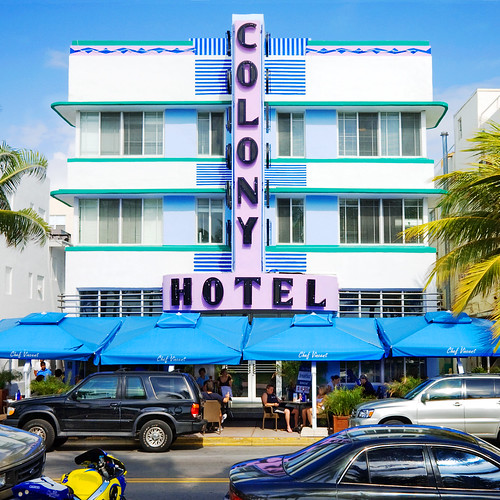When the names of certain cities are mentioned, photographic images of them pop into your head almost immediately. Washington = buildings on or near the mall. New York = skyscrapers of one sort or another. Paris = the Eiffel Tower. Tokyo = the Ginza shopping and entertainment district. With that thought in mind—and considering the multiple roles photography plays in shaping, documenting and marketing cities—we thought it would be interesting to explore how photographic images become symbolic and defining ones for metropolitan centers.
Miami sounded like a good city to focus on because it conjures up so many vivid and photographic images. Picture postcards of oranges, beaches, palm trees, coconuts, and crocodiles. Promotional images of mid-century hotels, swimming pools, and pastel-colored Art Deco buildings in the South Beach district. Television shows like Miami Vice, which ran 1984–1989 and, as People Magazine described it, "was the first show to look really new and different since color TV was invented."
The city photographs well. The light is bright and crisp; the weather’s great most of the time, which makes photographers’ jobs a lot easier to do. Every time I’ve been in Miami, I’ve walked by fashion shoots in progress. One afternoon, eating lunch at an outdoor café on Ocean Drive, I decided to keep count of the models, out on calls for their agencies and clutching their portfolios under their arms, who roller-skated by. There were lots of them.
Miami, of course, has its serious side. It’s a huge metropolitan area, a center of global trade, and has the largest concentration of international banks in the country. Historically, as the city has grown, and as real estate developers and architects have shaped and reshaped the city, photography has played a central role in the process. Which explains what led me to Allan Schulman, an architect, urban designer, and writer from Miami, whose work focuses on tropical architecture, housing, and regional design history. His story for click!, based on elegant black-and-white photographs made by Samuel Gottscho raises some provocative ideas about how photography shapes our experience of, and in cities. To read Allan’s story, click here.
Produced by the Smithsonian Institution Archives. For copyright questions, please see the Terms of Use.



Leave a Comment